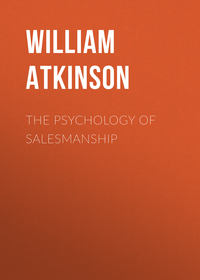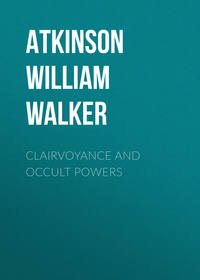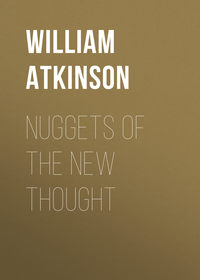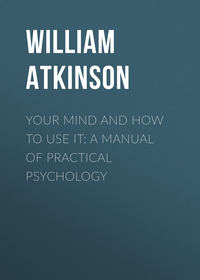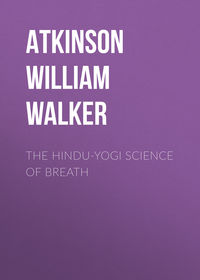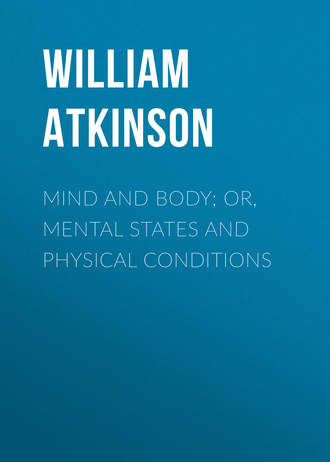 полная версия
полная версияMind and Body; or, Mental States and Physical Conditions
Following the law of self-preservation, we find that of accommodation manifesting itself in the vital activities of the Subconscious Mind. This principle or law works in the direction of adjusting the organism to conditions which it cannot remedy. Thus a sapling bent out of shape, will bend its branches upward until once more they will reach toward the sky notwithstanding the deformed trunk. Seed sprouting from a narrow crevice in a rock, and unable to split the rock, will assume a deformed shape but will hold tenaciously to life, and will thrive under these abnormal conditions. This principle of accommodation acts upon the idea of “life at any price,” and of “making the best of things.” Man and the lower animals accommodate themselves to their environment, when they are unable to overcome the unsatisfactory conditions of the latter. The study of anthropology, natural history, and botany will convince anyone that the principle of accommodation is everywhere present in connection with that of self-preservation. And the diseased conditions, and abnormal functioning, which we find in cases of chronic diseases is simply the principle of accommodation in the vital activities of the Subconscious Mind, but which it is “trying to make the best of it,” and holding on to “life at any price.”
Dr. Murphy, previously quoted, says: “Disease, in its essential nature, has a deeper significance than simply abnormal manifestations. It is really a remedial effort, not necessarily successful, but an attempt to change, or have changed existing conditions. And for this reason any improper relation of the living organism to external agents necessarily results in an injury to that organism, which by virtue of its being self-preservative, immediately sets up defensive action, and begins as soon as possible to repair the damages that have accrued. This defensive or reparative action, of course, corresponds to the conditions to be corrected, and hence is abnormal and diseased; and its severity and persistence will depend upon the damages to be repaired, and the intensity and persistence of the causes that produced it. Serious injury present or impending will demand serious vital action; desperate conditions, desperate action. But in all cases the action is vital, an attempt at restoration, and the energy displayed will exactly correspond to the interests involved and the vitality that is available.”
From the above, and from what has been shown in previous chapters, it will be seen that just as is health the result of the normal functioning of the Subconscious Mind, so is disease the result of its abnormal functioning. And it may also be seen that the true healing power must come alone from and through the Subconscious Mind itself, although the same may be aroused, awakened and directed by various outside agencies. As Dr. Thomson J. Hudson says: “Granted that there is an intelligence that controls the functions of the body in health, it follows that it is the same power or energy that fails in case of disease. Failing, it requires assistance; and that is what all therapeutic agencies aim to accomplish. No intelligent physician of any school claims to be able to do more than to ‘assist nature’ to restore normal conditions of the body. That it is a mental energy that thus requires assistance, no one denies; for science teaches us that the whole body is made up of a confederation of intelligent entities, each of which performs its functions with an intelligence exactly adapted to the performance of its special duties as a member of the confederacy. There is, indeed, no life without mind, from the lowest unicellular organism up to man. It is therefore a mental energy that actuates every fiber of the body under all its conditions. That there is a central intelligence that controls each of these mind organisms, is self-evident… It is sufficient for us to know that such an intelligence exists, and that, for the time being, it is the controlling energy that normally regulates the action of the myriad cells of which the body is composed. It is, then, a mental organism that all therapeutic agencies are designed to energize, when, for any cause, it fails to perform its functions with reference to any part of the physical structure.”
CHAPTER V
THE HISTORY OF PSYCHO-THERAPY
One of the most remarkable achievements of the New Psychology is that of gathering up the scattered instances of the effect of the power of the mind over the body, under the various masks and guises worn during the ages, and uniting them in one broad and general synthesis in which is to be seen the one fundamental principle of Mental Healing operating under a thousand names, forms and theories, in every race, nation and clime in all ages past and present. The New Psychology is the great reconciler of the various theories, dogmas and speculations concerned with the subject of the strange cures effected by the mind, as well as with the equally strange adverse effect upon the physical organism of negative thoughts.
From the earliest days of history we find records of strange and marvelous cures effected by non-material agents. In some cases the effect is attributed to magical power, while in others, and the majority of cases, the cure is attributed to some particular religious belief, creed or ceremony. Not only in the folk-lore of the several races, and in their general traditions, but also in the written and graven record do we find traces of the universality of the principle of mental therapeutics.
H. Addington Bruce says: “Psychotherapy might well be cited in support of the old adage that there is nothing new but what has been forgotten. Traces of it are to be found almost as far back as authentic history extends, and even allusion to methods which bear a strong resemblance to those of modern times. The literature and monumental remains of ancient Egypt, Greece, Rome, Persia, India and China reveal a widespread knowledge of hypnotism and its therapeutic value. There is in the British Museum a bas-relief from Thebes which has been interpreted as representing a physician hypnotizing a patient by making ‘passes’ over him. According to the Ebers papyrus, the ‘laying on of hands’ formed a prominent feature of Egyptian medical practice as early as 1552 B. C., or nearly thirty-five hundred years ago; and it is known that a similar mode of treatment was employed by priests of Chaldea in ministering to the sick. So, also, the priests of the famous Temples of Health are credited with having worked numerous cures by the mere touch of the hands. In connection with these same Temples of Health were sleeping chambers, repose in which was supposed to be exceptionally beneficial. Asclepiades of Bithynia, who won considerable fame at Rome as a physician, systematically made use of the ‘induced trance’ in the treatment of certain diseases. Plautus, Martial, and Seneca refer in their writings to some mysterious process of manipulation which had the same effect – that is, of putting persons into an artificial sleep. And Solon sang, apparently, of some form of mesmeric cure:
“‘The smallest hurts sometimes increase and rageMore than all art of physic can assuage;Sometimes the fury of the worst diseaseThe hand by gentle stroking, will appease.’“Many other instances might be mentioned testifying to the remarkable extent to which psycho-therapy, in one form or another, was utilized in the countries of the ancient world. This, of course, does not necessarily imply that the ancients had any real understanding of the psychological and physiological principles governing its operation. On the contrary, there is every reason to believe that they used it much as do too many of the mental healers of to-day – on the basis of ‘faith cure’ pure and simple, with no attempt at diagnosis, and in a hit-or-miss fashion. It was not until the very end of the Middle Ages, so far as history informs us, that anything even remotely resembling a scientific inquiry into its nature and possibilities was undertaken, and then only in a faint, vague, indefinite way, by men who were metaphysicians and mystics rather than scientists. The first of these, Petrys Pomponatius, a sixteenth-century philosopher, sought to prove that disease was curable without drugs, by means of the ‘magnetism’ existing in certain specially gifted individuals. ‘When those who are endowed with this faculty,’ he affirmed, ‘operate by employing the force of the imagination and the will, this force affects their blood and their spirits, which produce the intended effects by means of an evaporation thrown outwards.’ Following Pomponatius, John Baptist von Helmont, to whom medical science owes a great deal, also proclaimed the curative virtue of magnetism, which he described as an invisible fluid called forth and directed by the influence of the human will. Other writers, notably Sir Kenelm Digby, laid stress on the power of the imagination as an agent in the cause as well as the cure of disease, compiling in a curious little treatise published in 1658, as interesting a collection of illustrative cases as is contained in the literature of modern psycho-therapy.”
In the Middle Ages, we read that there were many instances of miraculous cures effected at the various shrines of the saints, and in the churches in which were exhibited the bones and other relics of the holy people of church history. As Dr. George R. Patton says: “A word scrawled upon parchment, for instance, would cure fevers; an hexameter from the Iliad of Homer cured gout, while rheumatism succumbed to a verse from Lamentations. These could be multiplied, and undoubtedly all were equally potent of cure in like manner… At one time holy wells were to be found in almost every parish of Ireland, to which wearisome journeys were made for the miraculous powers of cure. It was the custom of the cured to hang upon the bushes contiguous to the springs small fragments of their clothing, or a cane, or a crutch as a memento of cure, so that from afar the springs could be easily located by the many colored fragments of clothing, rags, canes and crutches swayed upon the branches by the wind. Inasmuch as the bushes for many rods around were thus adorned, the cures must have been far from few.”
In the Middle Ages it was the custom of persons afflicted with scrofula and kindred disorders to come before the king upon certain days to receive the “Royal Touch,” or laying-on-of-hands which was held to be an infallible specific for the disease. The custom was instituted by Edward the Confessor, and continued until the accession to power of the house of Brunswick. It is a matter of history that many persons were cured by the touch of the king’s hands. Wiseman, a celebrated surgeon and physician of old London testifies as follows: “I myself have been an eye-witness of many thousands of cures performed by his majesty’s touch alone, without any assistance of medicine or surgery, and those, many of them, such as had tired out the endeavors of able surgeons before they came hither… I must needs profess that what I write will little more than show the weakness of our ability when compared with his majesty’s, who cureth more in one year than all the surgeons of London have done in an age.” The virtue of the “King’s Touch” was finally brought in doubt by the wonderful successes of a man by the name of Valentine Greatrakes, who in the Seventeenth Century began “laying on hands” and made even more wonderful cures than those of the king. So marked was his success that the government had difficulty in suppressing the growing conviction among the common people that Greatrakes must be of royal blood, and the rightful heir to the throne, because of the great healing virtues of his hands, which, they argued, could be possessed only by those having royal blood in their veins. The Chirurgical Society of London investigated Greatrakes’ cures, and rendered an opinion that he healed by virtue of “some mysterious sanative contagion in his body.”
But perhaps the most notable figure in the European history of Mental Healing was Franz Anton Mesmer, a native of Switzerland, who was born in 1734, and who later in the century created the greatest excitement in several European countries by his strange theories and miraculous claims. Frank Podmore in a recent work says of Mesmer: “He had no pretensions to be a thinker; he stole his philosophy ready-made from a few belated alchemists; and his entire system of healing was based on a delusion. His extraordinary success was due to the lucky accident of the times. Mesmer’s first claim to our remembrance lies in this – that he wrested the privilege of healing from the churches and gave it to mankind as a universal possession.”
Mesmer held that there was in Nature a universal magnetic force which had a powerful therapeutic effect when properly applied. He cured many people by touching them with an iron rod, through which he claimed the universal magnetism flowed from his body to that of the patient. He called this magnetic fluid “animal magnetism.” Later on he devised his celebrated “magnetic tub” or baquet, by means of which he was able to treat his patients en masse. Podmore gives the following interesting account of scenes surrounding his treatments:
“The baquet was a large oaken tub, four or five feet in diameter and a foot or more in depth, closed by a wooden cover. Inside the tub were placed bottles full of water disposed in rows radiating from the center, the necks in some of the rows pointing towards the center, in others away from it. All these bottles had been previously ‘magnetized’ by Mesmer. Sometimes there were several rows of bottles, one above the other; the machine was then said to be at high pressure. The bottles rested on layers of powdered glass and iron filings. The tub itself was filled with water. The whole machine, it will be seen, was a kind of travesty of the galvanic cell. To carry out the resemblance, the cover of the tub was pierced with holes, through which passed slender iron rods of varying lengths, which were jointed and movable, so that they could be readily applied to any part of the patient’s body. Round this battery the patients were seated in a circle, each with his iron rod. Further, a cord, attached at one end to the tub, was passed round the body of each of the sitters, so as to bind them all into a chain. Outside the first a second circle would frequently be formed, who would connect themselves together by holding hands. Mesmer, in a lilac robe, and his assistant operators – vigorous and handsome young men selected for the purpose – walked about the room, pointing their fingers or an iron rod held in their hands at the diseased parts.”
Mesmer made many wonderful cures, and attracted wide attention. In 1781 the king of France offered him a pension of thirty thousand livres if he would make public his secret. The offer was refused, but he gave private instruction and opened a school. He had many pupils and followers, prominent among whom was the Marquis de Puysegur, who made discoveries resulting in the identification of Mesmerism with the “trance condition” now commonly associated with the term, whereas originally Mesmerism included simply the healing process. Mesmer’s methods continued popular for many years after his death, until Braid’s work resulted in the founding of the modern school of Hypnotism, and Mesmerism died out.
The Abbe Faria, about 1815, after investigating Mesmerism and attracting much attention, discarded the “fluidic” theory of Mesmer, and held, instead, that in order to induce the mesmeric state and to produce the phenomena thereof, it was necessary merely to create a mental state of “expectant attention” on the part of the patient. The cause of the state and the phenomena, he held, was not in the operator but in the mind of the patient – purely subjective, in fact. Alexander Bertrand, a Frenchman, published a work about this time, holding theories similar to those of Faria. In 1841 James Braid, an English physician, becoming interested in Mesmerism, discovered that the mesmeric state might be artificially induced by staring at bright objects until the eyes became fatigued, etc., and, later, that any method whereby concentration and “expectant attention” might be induced would produce the phenomenon. He duplicated all the feats of the mesmerists, including the healing of diseases. He called his new system “Hypnotism” to distinguish it from Mesmerism, and under its new name it gained favor among the medical fraternity. Moreover, in connection with his predecessors, Faria and Bertrand, he laid the basis for the modern theories of Suggestive Therapeutics.
Shortly after Braid’s death, in 1860, Dr. A. A. Liebault, a French physician, established his since famous School of Nancy, in which during the after years the later wonderful discoveries in Suggestive Therapeutics were made. He used the methods of hypnotism, but Suggestion was ever the operative principle recognized and applied. Liebault said: “It is all a matter of Suggestion. My patients are suggested to sleep, and their ills are suggested out of them. It is very simple, once you understand the laws of Suggestion.” Dr. Charcot, in his celebrated clinic in the Salpetriere, in Paris, did great work along the same general lines, although proceeding under somewhat different theories. Following the example of these and other eminent authorities, the medical fraternity has gradually adopted many of the ideas of Suggestive Therapeutics, and to-day many of the best medical schools throughout this country and Europe give instruction in this branch of healing. Many books have been written on the subject by eminent medical authorities, and the indications are that during the present century Suggestive Therapeutics, in its various forms, will come even more prominently into popular favor, and that it will be developed far beyond its present limits. Experimental work along these lines is now being conducted in many psychological laboratories in our great universities.
At the same time, as we shall now see, Mental Healing has been attracting much attention along other lines, outside of the medical profession, and often allied with religious and metaphysical movements. To understand the subject, we must study it in all of its phases.
In the early part of the nineteenth century Elijah Perkins, an ignorant blacksmith living in Connecticut conceived a queer idea of curing disease by means of a peculiar pair of tongs manufactured by himself, one prong being of brass and the other of steel. These tongs were called “tractors,” and were applied to the body of the patient in the region affected by disease, the body being stroked in a downward direction for a period of about ten minutes. The tractors were used to treat all manner of complaints, ailments and diseases, internal and external, with a wonderful degree of success. Almost miraculous cures of all manner of complaints were reported, and people flocked to Perkins from far and near in order to receive the benefit of his wonderful treatments.
Soon this system of healing came to be called “Perkinsism,” as a tribute to the inventor. The popularity of the system spread rapidly in the United States, particularly in New England, every city and many towns patronizing Perkins’ practitioners and healers. From this country the craze spread to Great Britain, and even to the Continent. Centers of treatment, and even hospitals, were established by the “Perkinsites,” and the fame of the tractors increased daily in ever widening circles. In Europe alone it is reported that over 1,500,000 cures were performed, and the medical fraternity were at their wit’s ends to explain the phenomenon. Finally, Dr. Haygarth, of London, conceived the idea that the real virtue of the cures was vested in the minds, belief and imagination of the patients rather than in the tractors, and that the cures were the result of the induced mental states of the patients instead of by the metallic qualities of the apparatus. He determined to investigate the matter under this hypothesis, and accordingly constructed a pair of tractors of wood, painted to resemble the genuine ones. The following account by Bostock describes the result: “He accordingly formed pieces of wood into the shape of tractors and with much assumed pomp and ceremony applied them to a number of sick persons who had been previously prepared to expect something extraordinary. The effects were found to be astonishing. Obstinate pains in the limbs were suddenly cured; joints that had long been immovable were restored to motion, and, in short, except the renewal of lost parts or the change in mechanical structure, nothing seemed beyond their power to accomplish.” The exposure of this experiment, and the general acceptance of the explanation of the phenomena, caused “Perkinsism” to die out rapidly, and at the present time it is heard of only in connection with the history of medicine and in the pages of works devoted to the subject of the effect of the mind over the body.
The success of “Perkinsism” is but a typical instance which is duplicated every twenty years or so by the rapid rise, spread and then rapid decline of some new “craze” in healing, all of which, when investigated are seen to be but new examples of the power of the mental states of faith and imagination upon the physical organism. The well-known “blue glass” craze of about thirty-five years ago gives us another interesting example. General Pleasanton, a well-known and prominent citizen of Philadelphia, announced his discovery that the rays of the sun passing through the medium of blue glass possessed a wonderful therapeutic value. The idea fired the public imagination at once, and the General’s book met with a large sale. Everyone, seemingly, began to experiment with the blue glass rays. Windows were fitted with blue glass panes, and the patients sat so that the sun’s rays might fall upon them after passing through the blue panes. Wonderful cures were reported from all directions, the results of “Perkinsism” being duplicated in almost every detail. Even cripples reported cures, and many chronic and “incurable” cases were healed almost instantaneously. Bedridden people threw aside their blankets and walked again, after a brief treatment. The interest developed into a veritable “craze,” and the glass factories were operated overtime in order to meet the overwhelming demand for blue glass, the price of which rapidly advanced to fifty cents and even a dollar for a small pane, because of the scarcity. It was freely predicted that the days of physicians were over, and that the blue glass was the long-sought-for panacea for all human ills. Suddenly, however, and from no apparent cause, the interest in the matter dropped, and now all that is left of the blue glass craze is the occasional sight of an old blue pane in some window, the owner of which evidently felt disinclined to pay the price of replacing it with a clear pane. Only a few days ago, in an old-fashioned quarter of a large city, the writer saw several panes of the old blue glass in the frame of the window of an old house which had seen better days but which was now used as a cheap tenement house.
The history of medicine is filled with records of similar “crazes” following the announcement of some new method of “cure.” The striking peculiarity of these cures is that they all occur during the height of the excitement and notoriety of the early days of the announcement, while they decline in proportion to the decline in public faith and interest, the explanation being that in every instance the cure is effected by the action of the mental states of expectancy, faith, and the imagination of the patient, irrespective of any virtue in the method or system itself. In short, all these cures belong to the category of faith-cures– they are merely duplicates of the world-old cures resulting from faith in sacred relics, shrines, bones of holy people, sacred places, etc., of which nearly every religion has given us many examples. The history of medicine gives us many instances of the efficacy of the therapeutic power of Faith.
Sir Humphrey Davy relates a case in which a man seriously ill manifested immediate improvement after the placing of a clinical thermometer in his mouth, he supposing that it was some new and powerful healing instrument. The grotesque remedies of the ancient physicians, and the bizarre decoctions of the quacks of the present, all work cures. The “bread-pills” and other placebos of the “regulars” have cured many a case when other remedies have failed.
It is related that several hundred years ago, a young English law-student while on a lark with several of his boon companions found themselves in a rural inn, without money with which to pay their reckoning. Finally, after much thought, the young man called the inn-keeper and told him that he, the student, was a great physician, and that he would prepare for him a magic amulet which would cure all diseases, in return for the receipted account of himself and friends. The landlord gladly consented, and the young man wrote some gibberish on a bit of parchment, which together with sundry articles of rubbish he inserted in a silk cover. With a wise and dignified air he then departed. Many years rolled by, and the young man rose to the position of a High Justice of the realm. One day before him was brought a woman accused of magic and witchcraft. The evidence showed that she had cured many people by applying to their bodies a little magic amulet, which the church authorities considered to be the work of the devil. The woman, on the stand, admitted the use of the amulet and the many cures resulting therefrom, but defended herself by saying that the instrument of cure had been given to her father, now deceased, many years ago, by a great physician who had stopped at her father’s inn. She held that the cures were genuine medical cures resulting from the medicinal virtues of the amulet, and not the result of magic or witchcraft. The Justice asked to be handed the wonderful amulet. Ripping it open with his pen-knife, he found enclosed the identical scrawl inserted by himself many years before. He announced the circumstances from the bench, and discharged the woman – but the healing virtues of the amulet had disappeared, never to return. The cures were the result of the faith and imagination of the patients.




